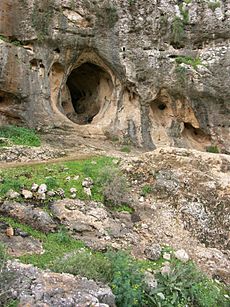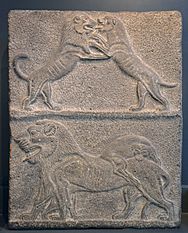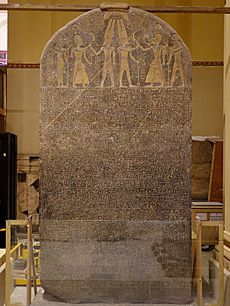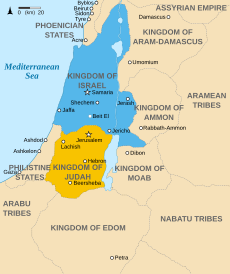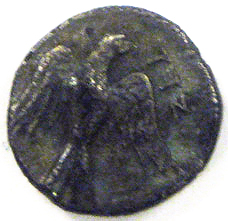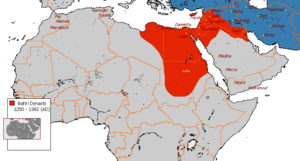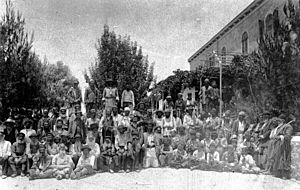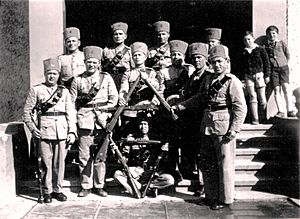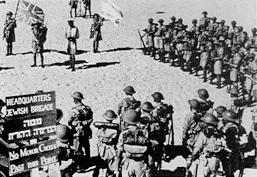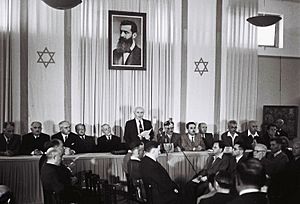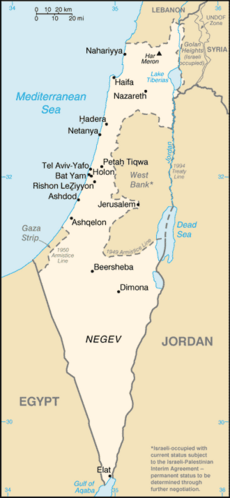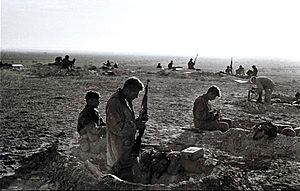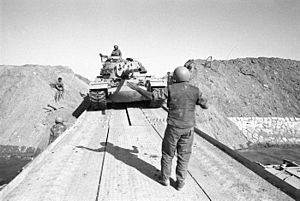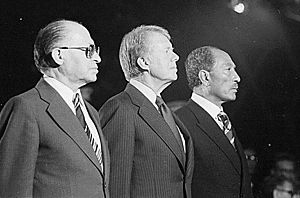History of Israel facts for kids

The history of Israel is about a special area in the Middle East, also known as Canaan, Palestine, or the Holy Land. This is where the modern countries of Israel and Palestine are located today. For a very long time, this land has been important for many different people and religions.
Long, long ago, early humans traveled through this area. Around 10,000 BCE, the Natufian culture developed here. Later, around 2,000 BCE, the Bronze Age began, and the Canaanite civilization grew. This region was later controlled by Egypt. In the Iron Age, the kingdoms of Israel and Judah were formed. These kingdoms were very important for the start of the Jewish and Samaritan peoples, and for religions like Judaism, Christianity, and Islam. Many different groups have lived and ruled here throughout history.
Over the next centuries, powerful empires like the Assyrians, Babylonians, and Persians took control. Then came the Ptolemies and Seleucids during the Hellenistic period. The Hasmonean dynasty brought a time of Jewish independence, but then the Roman Republic took over. After the Jewish-Roman Wars in the 1st and 2nd centuries CE, many Jews were killed or forced to leave. When Christianity became popular, Christians became the majority by the 4th century. But in the 7th century, Arab armies conquered the land, bringing Islam.
From the 11th to the 13th centuries, the Land of Israel was a battleground for the Crusades, religious wars between Christian and Muslim armies. Later, the Mongol invasions and conquests affected the area, but the Mamluk Sultanate eventually took control. The Mamluks ruled until the 16th century, when the Ottoman Empire conquered the region. It remained an Ottoman province until the 1900s.
In the late 1800s, a Jewish movement called Zionism grew. It encouraged Jews to return to the Land of Israel, a process called aliyah. During World War I, the Ottoman Empire was broken up. Britain was given control of the region, calling it Mandatory Palestine. The British promised to help create a Jewish homeland. However, Arab nationalism also grew, leading to tensions between Arabs and Jews.
In 1948, the Israeli Declaration of Independence created the modern State of Israel. This led to the 1948 Arab–Israeli War. Many Palestinians left their homes, and many Jews from Arab countries moved to Israel. Today, about 43% of all Jewish people live in Israel. In 1979, Israel signed a peace treaty with Egypt, and in 1994, with Jordan. In 1993, the Oslo I Accord was signed with the Palestine Liberation Organization, leading to the Palestinian National Authority. Despite efforts, the conflict between Israelis and Palestinians continues to be a major issue.
Contents
- Ancient Times: The Land's First People (2000–1000 BCE)
- Ancient Israel: Kingdoms and Empires (1200–550 BCE)
- Second Temple Period: Return and New Rulers (6th Century BCE–2nd Century CE)
- Later Roman and Byzantine Periods (2nd Century–634 CE)
- Early Muslim Period (634–1099)
- Crusades and Mongols (1099–1291)
- Mamluk Period (1291–1517)
- Ottoman Period (1516–1917)
- British Mandate of Palestine (1920–1948)
- State of Israel (1948–present)
- The 1948 Arab–Israeli War
- Armistice Agreements and New Borders
- Building the New State (1948–1955)
- The Suez Crisis (1956)
- The Six-Day War (1967)
- Golda Meir's Leadership and the Yom Kippur War (1969–1974)
- Rabin's First Term and Peace Efforts (1974–1977)
- Begin's Era and Peace with Egypt (1977–1983)
- Shamir, Peres, and the First Intifada (1983–1992)
- Rabin's Second Term and the Oslo Accords (1992–1996)
- Netanyahu I and Barak (1996–2001)
- Sharon's Leadership and Disengagement (2001–2006)
- Olmert's Term and Conflicts (2006–2009)
- Netanyahu's Second Term (2009–2021)
- Recent Years: Bennett, Lapid, and Netanyahu III (2021–present)
- Population Changes Over Time
- Images for kids
- See also
Ancient Times: The Land's First People (2000–1000 BCE)
Early Humans and Stone Tools
The oldest signs of humans in what is now Israel are from 1.5 million years ago. These were found near the Sea of Galilee at a place called Ubeidiya. Flint tools found at Yiron are some of the oldest stone tools found outside Africa. Other ancient sites include Qesem and Manot caves.
Around 120,000 years ago, the oldest fossils of modern humans outside Africa were found in northern Israel. These are known as the Skhul and Qafzeh hominids. Around 10,000 BCE, the Natufian culture lived in this area.
Canaanite Civilization Flourishes
The Canaanites lived here during the Middle Bronze Age (2100–1550 BCE). They had independent city-states, often protected by huge earth walls. These walls created the "tells" (mounds) you can still see today.
Later, in the Late Bronze Age (1550–1200 BCE), Canaan became a vassal state of the New Kingdom of Egypt. This meant they paid tribute to Egypt. In 1457 BCE, Egyptian forces led by Pharaoh Thutmose III defeated Canaanite rulers at the Battle of Megiddo.
Changes in the Iron Age
Around 1200 BCE, the Middle East faced a big collapse. Egyptian control over Canaan ended. Many cities like Hazor and Beit She'an were damaged or destroyed. Two new groups appeared: the Sea Peoples, especially the Philistines, who settled on the southern coast, and the Israelites, who settled in the highlands. Both groups used iron tools and weapons, which were better than the older bronze ones.
Ancient Israel: Kingdoms and Empires (1200–550 BCE)
The First Israelites (Iron Age I)
The earliest mention of "Israel" is on an Egyptian stone called the Merneptah Stele, from about 1209 BCE. It says "Israel is laid waste." During this time, many small villages were built in the highlands of Canaan, especially in Samaria. These villages were home to up to 400 people. They mostly farmed and raised animals.
Many scholars believe the Israelites came from the Canaanite people. They developed a unique religion focusing on one God, Yahweh. They began to see themselves as "Israelite," different from the Canaanites. They avoided marrying outside their group and focused on family history and their special religion.
The Philistines, on the other hand, came from the Aegean world. Their cooking tools, their love for pork, and their special pottery show they were from a different place. Their cities were large and complex, showing a well-organized society.
The Kingdoms of Israel and Judah (Iron Age II)
Around the 10th century BCE, two Israelite kingdoms appeared: Judah and Israel. The Hebrew Bible says they were once a single kingdom ruled by Saul, David, and Solomon. Solomon is said to have built the First Temple in Jerusalem.
Historians agree that the northern Kingdom of Israel existed by 900 BCE and the Kingdom of Judah by 850 BCE. The Kingdom of Israel was richer and more powerful. Its capital moved between different cities before settling in Samaria. The Kingdom of Judah was smaller but more stable, with Jerusalem always as its capital.
In 854 BCE, Israel and Aram-Damascus fought against the Assyrians at the Battle of Qarqar. Another important discovery is the Mesha Stele, which tells how the Moabite king Mesha defeated Israel. It also mentions the god Yahweh and possibly the "House of David."
Assyrian Invasions and Their Impact
Around 732 BCE, the Assyrians invaded Israel. The Kingdom of Israel fell to the Assyrians around 720 BCE after a long siege of its capital, Samaria. The Assyrians took many people from Israel to Mesopotamia. This event led to the idea of the Ten Lost Tribes of Israel. Foreign groups were then settled in the land. The Samaritans say they are descendants of Israelites who stayed behind.
Many people from the destroyed Kingdom of Israel moved to Judah, causing Jerusalem to grow. King Hezekiah (ruled 715–686 BCE) built the Siloam Tunnel to bring water into the city during a siege. An inscription found in the tunnel tells about its construction.
During Hezekiah's time, the Assyrian king Sennacherib tried to capture Judah but failed to take Jerusalem. Assyrian records say Sennacherib destroyed 46 cities and besieged Jerusalem, but left after receiving a lot of tribute.
Important religious leaders called "prophets" like Hosea, Amos, Micah, and Isaiah lived during this time. They warned people about the Assyrian threat and encouraged them to follow ethical rules, seeing the invasions as punishment for bad behavior.
Under King Josiah (ruled 641–619 BCE), the Book of Deuteronomy was found or written. Other parts of the Bible, like the Book of Joshua and parts of the Books of Kings, are also believed to be from this period. These writings were important for the development of monotheism (belief in one God) in Judah.
Babylonian Period and Exile (587–538 BCE)
In the late 7th century BCE, Judah became a vassal state of the Neo-Babylonian Empire. In 601 BCE, King Jehoiakim of Judah allied with Egypt, which angered the Babylonians. As punishment, the Babylonians besieged Jerusalem in 597 BCE. They took King Jehoiachin and other important people to Babylon.
A few years later, King Zedekiah rebelled again. In 587 or 586 BCE, King Nebuchadnezzar II of Babylon conquered Jerusalem, destroyed the First Temple, and burned the city. The Kingdom of Judah ended, and many people were exiled to Babylon. The land became a Babylonian province called Yehud.
Second Temple Period: Return and New Rulers (6th Century BCE–2nd Century CE)
Persian Rule and Rebuilding (538–332 BCE)
In 538 BCE, Cyrus the Great of the Achaemenid Empire conquered Babylon. Cyrus allowed all people who had been exiled by the Babylonians to return home. According to the Bible, Jewish exiles, led by Zerubabel, returned to Judah to rebuild the Temple in Jerusalem. The Second Temple was finished around 515 BCE.
Another group, led by Ezra and Nehemiah, returned later. Ezra helped enforce religious laws from the Torah. Nehemiah, as governor, helped rebuild the city walls. The land remained a Persian province called Yehud.
The final version of the Torah (the first five books of the Bible) is thought to have been written during this Persian period. The Jewish people also adopted a new writing style, the Aramaic script, which they brought from Babylon. This is the basis for the modern Hebrew script.
Greek Rule and Jewish Independence (333–64 BCE)
In 332 BCE, Alexander the Great conquered the region. After he died, his generals divided his empire. Judea became a border area between two Greek kingdoms: the Seleucid Empire and the Ptolemaic Kingdom. For a century, the Ptolemies ruled, then the Seleucids took over in 200 BCE.
Greek rulers generally respected Jewish culture. However, some Jews adopted Greek ways, causing tension with those who wanted to keep Jewish traditions. This tension grew when Antiochus IV Epiphanes tried to force Greek customs on the Jews and made the Temple unholy.
In 167 BCE, the Maccabean revolt began. Mattathias, a Jewish priest, started the rebellion. His son, Judas Maccabeus, won battles against the Seleucids. In 164 BCE, he captured Jerusalem and rededicated the Temple. This event is celebrated during the Jewish festival of Hannukah.
After Judas's death, his brothers established the Hasmonean dynasty. They created an independent Jewish state, taking advantage of the Seleucid Empire's decline. Under leaders like John Hyrcanus, Judea grew in size. The Hasmoneans were the first Jewish rulers to mint their own coins.
During Hasmonean rule, important Jewish groups like the Pharisees, Sadducees, and Essenes emerged. The Pharisee sage Simeon ben Shetach is known for starting the first schools in meeting houses, which was a big step for Rabbinical Judaism.
Roman Rule and Major Revolts (64 BCE–2nd Century CE)
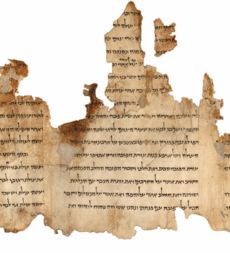
In 64 BCE, the Roman general Pompey conquered Syria and intervened in a Jewish civil war in Jerusalem. He made Judea a Roman vassal kingdom. From 37 BCE to 6 CE, the Herodian dynasty, Jewish-Roman kings, ruled Judea. Herod the Great greatly expanded the Temple, making it one of the largest religious buildings in the world.
In 6 CE, Judea became a Roman province. Tensions grew between the Roman and Jewish populations. In 64 CE, the Temple High Priest Joshua ben Gamla made it a rule for Jewish boys to learn to read from age six. This helped strengthen Jewish tradition.
The Jewish-Roman Wars
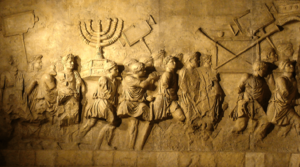
In 66 CE, the First Jewish-Roman War began. It was caused by harsh Roman rule, conflicts between rich and poor, and clashes between Jews and pagans. The Jewish rebels called their state "Israel." Despite early victories, the Jewish groups split, and the Roman army, led by Vespasian and Titus, eventually destroyed Jewish strongholds. In 70 CE, after a tough five-month siege, Jerusalem and the Second Temple were completely destroyed.
This war had huge effects. Many Jews died or were forced to leave. Without the Temple, Judaism had to change to survive. The Pharisees, led by Yochanan ben Zakai, started a school at Yavne. Their teachings became the foundation for Rabbinic Judaism, which is the main form of Judaism today.
From 115 to 117 CE, another big Jewish uprising, the Kitos War, happened across the Roman Empire. Then, in 132 CE, the Bar Kokhba revolt began. It was led by Simon Bar Kokhba, whom some rabbis saw as the messiah. This independent Jewish state was also called "Israel" on its coins. Christians did not join this revolt, which further separated Christianity from Judaism.
The Bar Kokhba revolt was crushed by Emperor Hadrian. Many Jews were killed, exiled, or sold into slavery. The province of Judea was renamed Syria Palaestina. This name change is often seen as a punishment or a way to remove the Jewish connection to the land, though scholars still debate the exact reason.
Later Roman and Byzantine Periods (2nd Century–634 CE)
Jewish Life After the Revolts
After the Bar Kokhba revolt, fewer Jews lived in the region. Many moved to Jewish communities in Babylonia and Arabia. However, a small Jewish presence remained, especially in Galilee, which became a religious center. During this time, the Mishnah and Jerusalem Talmud, large collections of Jewish religious discussions, were written in Tiberias and Jerusalem.
The Romans allowed a Jewish leader called the "Nasi" to represent the Jews. The most famous Nasi was Judah haNasi, who helped put together the final version of the Mishnah. He also made education more important for Jews. Many synagogues from this period have been found in Galilee.
Rise of Christianity and Byzantine Rule
In the early 4th century, Emperor Constantine made Christianity an accepted religion in the East Roman Empire (later called the Byzantine Empire). His mother, Helena, visited Jerusalem and helped build important churches like the Church of the Nativity and the Church of the Holy Sepulchre. Jerusalem became a Christian city. Jews were still not allowed to live in Jerusalem, but they could visit the ruined Temple site.
The Roman Empire split in 390 CE, and the region became part of the Byzantine Empire. Christian pilgrims flocked to the holy sites, boosting the economy and changing who lived there. Many monasteries were built, encouraging local people to convert to Christianity.
Judaism was the only non-Christian religion allowed, but restrictions on Jews slowly increased. They were banned from building new places of worship, holding public office, or owning Christian slaves. In 425, the Sanhedrin, a Jewish religious court, was officially abolished.
In 611, the Persian Empire invaded the Byzantine Empire. Jewish fighters helped the Persians capture Jerusalem in 614. Christian historians claimed Jews massacred Christians, but there's no archaeological proof. In 628, the Byzantines regained control, and Emperor Heraclius massacred Jews in Galilee and Jerusalem, again banning Jews from Jerusalem.
Early Muslim Period (634–1099)
Arab Conquest and New Capitals
In 635, an Arab army conquered the region, making it part of the Rashidun Caliphate. Two military districts were set up: Jund Filastin and Jund al-Urdunn. A new city, Ramlah, became the Muslim capital of Jund Filastin. The Byzantine ban on Jews living in Jerusalem ended.
In 661, Muawiyah was crowned Caliph in Jerusalem, starting the Umayyad Caliphate. In 691, Caliph Abd al-Malik built the Dome of the Rock shrine on the Temple Mount, where the Jewish Temples had stood. The Al-Aqsa Mosque was also built there in 705.
In 750, the Abbasid Revolution replaced the Umayyads. The Abbasids built a new capital, Baghdad. This was a time of great scientific progress, known as the Islamic Golden Age. However, in the 8th century, Caliph Umar II made laws requiring Jews and Christians to wear special identifying clothes. Non-Muslims also had to pay a special tax called jizya.
Changes in Population
The Arab conquest changed the population of the country. Over several centuries, the population dropped significantly. There was a slow process of Islamization, as some non-Muslims left, Muslims moved in, and some local people converted to Islam.
Many Christians and Samaritans moved away from the coastal cities. These cities, like Ashkelon and Gaza, were then settled by Muslims and became important Muslim centers. The region of Samaria also saw many Samaritans convert to Islam. While there's no strong evidence of forced conversions, economic difficulties and heavy taxes may have encouraged some to convert.
Crusades and Mongols (1099–1291)
The Crusader Kingdom
In 1099, the First Crusade captured Jerusalem and set up a Catholic kingdom called the Kingdom of Jerusalem. During the conquest, many Muslims and Jews were killed or sold into slavery. Jews in Europe were often forced to choose between converting or dying.
Around 1180, a Crusader ruler named Raynald of Châtillon caused conflict with the Ayyubid Sultan Saladin. This led to the Crusaders' defeat at the 1187 Battle of Hattin. Saladin then peacefully took Jerusalem and most of the Crusader kingdom. Saladin's doctor was Maimonides, a famous Jewish scholar who had fled persecution in Spain.
The Christian world responded with the Third Crusade in 1190. After battles, Richard the Lionheart and Saladin signed a treaty in 1192. Christians could visit holy sites, but Jerusalem remained under Muslim rule. In 1229, Jerusalem briefly returned to Christian control through a treaty. However, in 1244, the city was sacked by the Khwarezmian Tatars, who destroyed it and drove out the Jews.
Mamluk Period (1291–1517)
Between 1258 and 1291, the area was a battleground between Mongol invaders and the Mamluks of Egypt. This conflict made the country poor and reduced its population.
The Mamluks were a group of warrior slaves, mostly of Turkish origin, who took control of Egypt. The first Mamluk Sultan, Qutuz, defeated the Mongols at the Battle of Ain Jalut, stopping their advance. His general, Baibars, then removed most of the Crusader strongholds. The Mamluks ruled Palestine until 1516.
The Mamluks intentionally destroyed coastal areas and ports to prevent future Crusader attacks. This left these areas sparsely populated for centuries. Activity shifted more inland.
After Jews were expelled from Spain in 1492 and Portugal in 1497, many moved east. Some settled in Mamluk Palestine, especially in cities like Safed and Jerusalem. This brought new life to the local Jewish community.
Ottoman Period (1516–1917)
Life Under Ottoman Rule
The Ottoman Turks conquered the area in 1516–17. It became part of the province of Ottoman Syria for the next four centuries.
Jewish immigration continued under the Ottomans. In 1558, Sultan Selim II gave control of Tiberias to Doña Gracia Mendes Nasi, a wealthy Jewish woman who had escaped the Inquisition. She encouraged Jewish refugees to settle there. Safed became a center for studying Kabbalah, a type of Jewish mysticism.
In 1660, a Druze conflict led to the destruction of Safed and Tiberias. In the late 1700s, a local Arab leader, Zahir al-Umar, created a nearly independent state in Galilee.
In 1799, Napoleon briefly occupied the country and thought about inviting Jews to create a state. But his defeat at Acre stopped this plan. In 1831, Muhammad Ali of Egypt, an Ottoman ruler who modernized Egypt, conquered Ottoman Syria.
By 1844, Jews were the largest population group in Jerusalem. By 1896, they were the majority in Jerusalem itself, but the overall population in Palestine was still mostly Muslim (88%) and Christian (9%).
The Start of Zionism
Between 1882 and 1903, about 35,000 Jews moved to Palestine in what was called the First Aliyah. Many came from the Russian Empire, where Jews faced increasing persecution. Groups like Bilu and Hovevei Zion ("Lovers of Zion") aimed to settle in Palestine. They established farming villages like Petah Tikva (1878) and Rishon LeZion (1882). These new settlements often relied on funding from people like Baron Edmond James de Rothschild.
In 1896, Theodor Herzl wrote Der Judenstaat (The Jewish State), suggesting that Jews needed their own state to solve the problem of antisemitism in Europe. In 1897, the World Zionist Organization was founded, aiming to create "a home for the Jewish people in Palestine."
Between 1904 and 1914, about 40,000 more Jews settled in the area (the Second Aliyah). In 1909, residents of Jaffa bought land and built the first all-Hebrew speaking town, Ahuzat Bayit, which later became Tel Aviv.
World War I and the Balfour Declaration
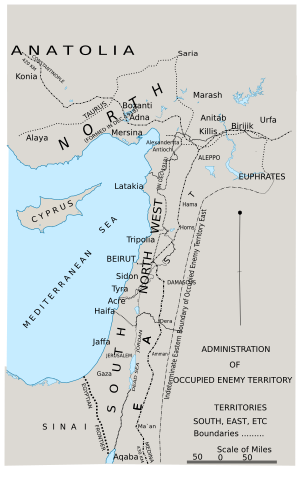
During World War I, Britain sought Jewish support. In 1917, the British foreign minister, Arthur Balfour, sent a letter to Lord Rothschild, a Jewish leader. This letter, known as the Balfour Declaration, stated that the British Government "view[ed] with favour the establishment in Palestine of a national home for the Jewish people." This declaration gave Britain a reason to claim and govern the country.
A Jewish Legion of Zionist volunteers fought with the British. The Nili Zionist spy network also provided information to the British about Ottoman plans. After the Ottomans were pushed out, Palestine was governed by the British, French, and Arabs until 1920.
British Mandate of Palestine (1920–1948)
Early Years of British Rule
The British Mandate (British rule) was confirmed by the League of Nations in 1922 and started in 1923. It included the Balfour Declaration. The area of Transjordan was also part of the Mandate but had separate rules.
After the Russian Civil War (1918-1921), many pogroms (attacks) against Jews happened in Russia. This led to more Jewish migration to Palestine. Between 1919 and 1923, about 40,000 Jews arrived in the Third Aliyah. Many were Socialist Zionists who established self-sustaining farms called Kibbutzim. They drained swamps and bought land through the Jewish National Fund.
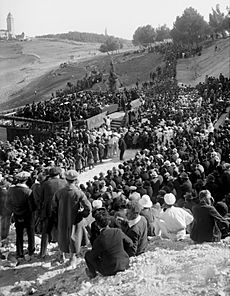
After France defeated the Arab Kingdom of Syria, hopes for Arab independence faded. Clashes between Arabs and Jews occurred in Jerusalem (1920) and Jaffa (1921), leading to the creation of the Haganah, an underground Jewish militia.
A Jewish Agency was created to manage Jewish immigration and funds. Between 1924 and 1929, over 80,000 Jews arrived in the Fourth Aliyah. Many fled antisemitism and economic problems in Poland and Hungary. In 1925, the Jewish Agency established the Hebrew University in Jerusalem and the Technion (a technology university) in Haifa.
In 1929, tensions grew over the Kotel (Wailing Wall), a holy site for Jews. The British banned Jews from using chairs or curtains there. The Mufti of Jerusalem claimed it was Muslim property. This led to the August 1929 Palestine riots. The ancient Jewish community in Hebron was massacred. These riots led to the creation of the Irgun, a right-wing Zionist militia, in 1931, which favored a more aggressive approach.
The British faced a challenge: how to support a Jewish homeland while preparing the country for self-rule, when Arabs were the majority. They refused to allow majority rule, which would give Arabs control.
Increased Jewish Immigration and Arab Revolt
Between 1929 and 1938, 250,000 Jews arrived in Palestine (Fifth Aliyah). Many were fleeing Nazi Germany. The Ha'avara Agreement allowed some German Jews to transfer their possessions to Palestine by buying German goods.
This large Jewish immigration and Nazi propaganda contributed to the 1936–1939 Arab revolt in Palestine. This was a nationalist uprising against British rule. The head of the Jewish Agency, David Ben-Gurion, adopted a policy of "Havlagah" (self-restraint) to avoid being provoked by Arab attacks. The Irgun disagreed and broke away from the Haganah.
The British responded with the Peel Commission (1936–37), which suggested dividing Palestine into separate Jewish and Arab territories. Jewish leaders like Chaim Weizmann and Ben-Gurion considered it, but the Palestinian Arab leadership rejected it completely and renewed the revolt.
In 1938, the US held a conference to discuss the large number of Jews trying to escape Europe. Britain insisted Palestine not be discussed. With millions of Jews trapped in Europe and most countries closed to them, Britain decided to limit Jewish immigration to Palestine. The White Paper of 1939 allowed only 75,000 Jewish immigrants over five years, after which Arab approval would be needed. Both Arabs and Jews rejected this plan. Jews then resorted to illegal immigration, known as Aliyah Bet.
World War II and the Holocaust
During Second World War, the Jewish Agency wanted to form a Jewish army to fight with the British. In June 1940, Italy bombed Tel Aviv and Haifa. In May 1941, the Palmach was formed to defend the Jewish community against a possible Axis invasion. Despite British policies, 30,000 Palestinian Jews and 12,000 Palestinian Arabs joined the British armed forces. In June 1944, the British agreed to create a Jewish Brigade that fought in Italy.
Between 1939 and 1945, the Nazis systematically killed about 6 million Jews in Europe in what is known as the Holocaust. This destroyed many Jewish communities, especially in Poland and Germany. After the war, most Jewish survivors were refugees who wanted to go to Palestine.
The British Labour government, elected in 1945, decided to continue the 1939 White Paper policies, limiting Jewish immigration.
Illegal Immigration and Conflict

Illegal immigration (Aliyah Bet) became the main way for Jews to enter Palestine. Organizations like Bricha smuggled Holocaust survivors from Eastern Europe to Mediterranean ports. Small boats tried to break the British blockade. Despite British efforts, over 110,000 Jews entered Palestine this way. By the end of World War II, Jews made up 33% of Palestine's population.
Zionists began a guerrilla war against the British to gain independence. The Haganah, Irgun, and Stern Gang formed the Jewish Resistance Movement. In June 1946, the British arrested 2,700 Jews, including Jewish Agency leaders.
On July 4, 1946, a large pogrom in Poland caused more Holocaust survivors to flee to Palestine. Three weeks later, the Irgun bombed the British Military Headquarters at the King David Hotel in Jerusalem, killing 91 people. The British imprisoned Jews trying to enter Palestine in camps in Atlit and Cyprus.
By 1947, the British government decided to hand the Palestine problem over to the newly formed United Nations.
United Nations Partition Plan

On April 2, 1947, the United Kingdom asked the UN General Assembly to deal with Palestine. The UN created a committee, UNSCOP, to study the issue. In July 1947, UNSCOP visited Palestine. During their visit, the British sent passengers from an Aliyah Bet ship, the SS Exodus 1947, back to Europe.
The majority of UNSCOP recommended creating "an independent Arab State, an independent Jewish State, and the City of Jerusalem" under international control. On November 29, 1947, the General Assembly adopted this plan as Resolution 181. The plan also called for Britain to allow more Jewish migration.
Neither Britain nor the UN Security Council acted to enforce the plan. Britain continued to hold Jewish immigrants in Cyprus. The British withdrawal was completed in May 1948.
Civil War and Independence

The UN vote led to joy among Jews and anger among Arabs. Violence broke out, escalating into a civil war. From January 1948, fighting became more organized. The Arab Liberation Army intervened, and Abd al-Qadir al-Husayni organized a blockade of Jewish Jerusalem.
Many Arabs from cities like Haifa and Jaffa left their homes. The US then withdrew its support for the partition plan, making the Arab League believe they could stop it. Britain decided to support Transjordan annexing the Arab part of Palestine.
David Ben-Gurion reorganized the Haganah and made military service mandatory for all Jewish men and women. With funds from the US and support from the Soviet Union, Jewish representatives bought weapons from Eastern Europe.
Ben-Gurion ordered the Haganah to go on the offensive. They aimed to connect Jewish areas by conquering mixed zones. Cities like Tiberias, Haifa, and Jaffa fell, causing over 250,000 Palestinian Arabs to flee. This situation was a major reason for neighboring Arab states to intervene.
On May 14, 1948, as the last British forces left, the Jewish People's Council declared the establishment of the State of Israel in Eretz Israel.
State of Israel (1948–present)
The 1948 Arab–Israeli War
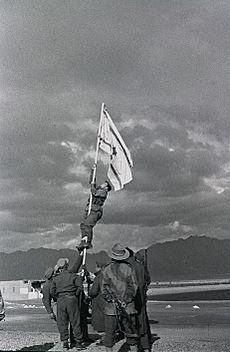
Immediately after Israel's declaration of independence, both the US and the Soviet Union recognized the new state. However, the Arab League countries (Egypt, Transjordan, Syria, Lebanon, and Iraq) refused to accept the UN partition plan. They sent their armies into what had been British Palestine, starting the first Arab–Israeli War.
On May 29, 1948, the UN Security Council declared an arms embargo on the region. However, Czechoslovakia supplied Israel with weapons. On June 11, a month-long UN truce began.
The Haganah became the Israel Defense Forces (IDF). Other Jewish militias were told to join the IDF. During the ceasefire, the Irgun tried to bring in a private arms shipment, but Ben-Gurion ordered the ship sunk when they refused to hand over the weapons.
Many Jewish immigrants, including Holocaust survivors, arrived in Israel and joined the IDF. After initial losses, Israel pushed back the Arab armies and gained control of more territory. On December 1, King Abdullah of Jordan announced the union of Transjordan with Arab Palestine west of the Jordan River.
Armistice Agreements and New Borders
Israel signed armistices (ceasefires) with Egypt, Lebanon, Jordan, and Syria in 1949. No actual peace agreements were signed. Israel's new borders, known as the Green Line, were established. These borders were not recognized by Arab states as international boundaries.
Israel controlled the Galilee, Jezreel Valley, West Jerusalem, the coastal plain, and the Negev. Jordan annexed the West Bank, and Egypt kept Gaza as an occupied zone.
After the ceasefire, Britain released Jewish detainees from Cyprus and recognized Israel. On May 11, 1949, Israel became a member of the United Nations. About 6,000 Israelis died in the war. According to UN figures, 726,000 Palestinians fled or were expelled between 1947 and 1949.
Building the New State (1948–1955)
The Knesset, Israel's 120-seat parliament, first met in Tel Aviv and then moved to Jerusalem. In January 1949, Israel held its first elections. The Socialist-Zionist party Mapai, led by David Ben-Gurion, won the most seats. Ben-Gurion became Prime Minister. Chaim Weizmann was elected the first (mostly ceremonial) President of Israel. Hebrew and Arabic became the official languages. All Israeli governments have been coalitions, as no single party has ever won a majority.
Within three years (1948-1951), immigration doubled Israel's Jewish population. About 700,000 Jews settled in Israel. Around 300,000 came from Asian and North African countries, including over 100,000 from Iraq. The rest came from Europe, many as refugees.
In 1950, the Knesset passed the Law of Return, which gives all Jews and people of Jewish ancestry the right to settle in Israel and become citizens. That year, 50,000 Yemenite Jews were secretly flown to Israel. In 1951, 120,000 Iraqi Jews moved to Israel. By the late 1960s, about 850,000 Jews from Arab countries had moved to Israel, France, or the Americas.

Between 1948 and 1958, Israel's population grew from 800,000 to two million. During this time, food, clothes, and furniture were rationed due to shortages. Many immigrants, who arrived with no money, lived in temporary camps. Israel received financial aid from abroad, especially from the United States. Ben-Gurion signed a controversial reparations agreement with West Germany to help the new state's finances.
In 1949, education became free and mandatory for all citizens up to age 14. The government funded different education systems, including secular and religious ones.
Israel initially tried to stay neutral between the US and the Soviet Union. However, antisemitic trials in the Soviet Union in the 1950s pushed Israel away from the Soviet bloc. In 1950, Egypt closed the Suez Canal to Israeli ships. In 1952, a military coup in Egypt brought Abdel Nasser to power. Israel sought good relations with France and newly independent African states.
Between 1953 and 1956, there were clashes along Israel's borders. Palestinian fedayeen (fighters) launched attacks from Egyptian-occupied Gaza, leading to Israeli counter-raids. In 1955, Egypt made a large arms deal with Czechoslovakia, changing the balance of power in the Middle East.
The Suez Crisis (1956)
In 1956, Egyptian President Nasser nationalized the Suez Canal, which was owned by France and Britain. Egypt also blocked the Gulf of Aqaba, stopping Israeli ships from reaching the Red Sea. Israel secretly agreed with France and Britain to coordinate military actions against Egypt.
On October 29, 1956, Israeli forces, led by General Moshe Dayan, attacked Egypt. On October 30, Britain and France called for both sides to withdraw from the Canal area, planning to take control themselves. Egypt refused, and the allies began air strikes. By November 5, Israel had taken over the Sinai Peninsula. The Anglo-French invasion began that day.
The UN, with the US and USSR agreeing, condemned these actions. A ceasefire was accepted on November 7. The UN sent an Emergency Force (UNEF) to supervise the ceasefire. Israel withdrew from Sinai after receiving US guarantees about access to the Suez Canal and an end to Palestinian raids from Gaza. The conflict showed the end of Western European dominance in the Middle East.
In 1959, skirmishes continued along Israel's borders. The economic boycott continued, and there was a dispute over water rights in the Jordan River. Arab states, supported by the Soviet Union, continued to build up their armies. France was Israel's main military supplier.
In May 1960, Adolf Eichmann, a key Nazi official responsible for the Holocaust, was found in Argentina by the Mossad (Israel's intelligence agency). He was kidnapped and brought to Israel. In 1961, he was put on trial, found guilty, and sentenced to death. He was executed in 1962, the only person ever sentenced to death by an Israeli court. The trial brought much public awareness to the Holocaust.
In 1963, Ben-Gurion resigned as Prime Minister, and Levi Eshkol took over.
The Six-Day War (1967)
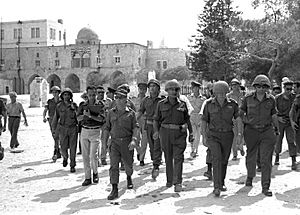
In 1964, Egypt, Jordan, and Syria formed a unified military command. Israel completed a huge engineering project, the national water carrier, to bring water from the Jordan River to the south. The Arabs tried to divert the Jordan's headwaters, leading to more conflict with Syria.
Until 1966, France was Israel's main arms supplier. But in 1966, France stopped supplying arms. The United States then took over, providing military equipment like tanks and aircraft to Israel.
On May 15, 1967, Syria, Egypt, and Jordan gathered troops along Israel's borders. Egypt closed the Straits of Tiran to Israeli shipping, which Israel considered an act of war. Egyptian radio broadcasts spoke of destroying Israel. On May 26, Nasser declared, "Our basic objective will be to destroy Israel." Egypt, Syria, Jordan, and Iraq signed defense agreements.
Israel called up its civilian reserves, bringing the economy to a halt. A national unity government was formed, including Menachem Begin's party for the first time. Moshe Dayan was appointed Defense Minister.
On June 5, 1967, the Israeli air force launched pre-emptive attacks against the Egyptian, Jordanian, and Syrian air forces, starting the Six-Day War. By June 11, the Arab forces were defeated. Israel gained control of the Sinai Peninsula, the Gaza Strip, the Golan Heights, and the formerly Jordanian-controlled West Bank of the Jordan River. East Jerusalem was annexed by Israel.
The Khartoum Resolution by Arab leaders on August 29, 1967, stated "no peace with Israel, no recognition of Israel, no negotiations with it." On November 22, 1967, the UN Security Council adopted Resolution 242, the "land for peace" formula. It called for peace based on Israeli withdrawal from territories occupied in 1967 in exchange for recognition and secure borders. Both sides accepted it, but with different interpretations.
In 1968, Moshe Levinger led a group of Religious Zionists to create the first Jewish settlement, Kiryat Arba, near Hebron. Also in 1968, compulsory education in Israel was extended to age 16.
In March 1968, Israeli forces attacked the Palestinian militia, Fatah, in Jordan. In early 1969, fighting broke out between Egypt and Israel along the Suez Canal, leading to the "War of Attrition" (1969–1970).
Golda Meir's Leadership and the Yom Kippur War (1969–1974)
In early 1969, Levi Eshkol died, and Golda Meir became Prime Minister. She was the first female prime minister of Israel and the first woman to lead a Middle Eastern state in modern times.
In December 1969, Israeli naval commandos took five missile boats from France that Israel had paid for but France refused to supply. In July 1970, Israelis shot down five Soviet fighters helping the Egyptians. A ceasefire was agreed in August 1970.
In September 1970, King Hussein of Jordan drove the Palestine Liberation Organization (PLO) out of his country. The PLO then moved its main activities to Lebanon.
Increased Soviet antisemitism led to many Soviet Jews wanting to emigrate to Israel. Many were refused exit visas and persecuted. In 1971, protests by the Israeli Black Panthers highlighted discrimination against Mizrahi Jews (Jews from Middle Eastern countries).
At the 1972 Munich Olympics, Palestinian terrorists killed two Israeli team members and took nine hostage. A rescue attempt failed, leading to the deaths of all remaining hostages and five hijackers. The Israeli government responded with assassination campaigns against those who organized the massacre.
In 1972, Egyptian President Anwar Sadat expelled Soviet advisers from Egypt. This, along with frequent Egyptian and Syrian military exercises, made Israel too confident about the threat. Despite warnings, Israel failed to mobilize its forces.
The Yom Kippur War (also called the October War) began on October 6, 1973. Syrian and Egyptian armies launched a surprise attack against the unprepared Israeli Defense Forces. Both the Soviets and Americans sent arms to their allies. The Syrians were pushed back, and while the Egyptians captured some territory in Sinai, Israeli forces outflanked them across the Suez Canal.
The war led to the 1973 oil crisis, where Saudi Arabia and OPEC countries embargoed oil to countries trading with Israel. This caused oil prices to skyrocket, and many countries broke off or downgraded relations with Israel.
In November 1974, the PLO was granted observer status at the UN, and Yasser Arafat spoke to the General Assembly. Public anger over Israel's lack of preparedness for the war led to Golda Meir's resignation.
Rabin's First Term and Peace Efforts (1974–1977)
After Meir resigned, Yitzhak Rabin became prime minister. Religious Zionists formed the Gush Emunim movement and began settling the West Bank and Gaza Strip. In November 1975, the UN General Assembly passed Resolution 3379, which said Zionism was a form of racism. This resolution was later canceled in 1991.
In July 1976, Rabin ordered Operation Entebbe to rescue kidnapped Jewish passengers from an Air France flight hijacked by Palestinian terrorists and flown to Uganda.
Rabin resigned in April 1977 after it was found that his wife had a dollar account in the United States, which was illegal at the time.
Begin's Era and Peace with Egypt (1977–1983)
In a surprising result, the Likud party, led by Menachem Begin, won the 1977 elections. This was the first time a non-leftist party led the government. In November 1977, Egyptian President Anwar Sadat visited Jerusalem and spoke at the Knesset. Sadat recognized Israel's right to exist and started direct talks.
In September 1978, US President Jimmy Carter invited Sadat and Begin to Camp David. They agreed on a framework for peace between Israel and Egypt, and for broader peace in the Middle East. The treaty was signed on March 26, 1979. Israel returned the Sinai Peninsula to Egypt in April 1982. The Arab League reacted by suspending Egypt. Sadat was assassinated in 1981 by Islamic fundamentalists who opposed peace with Israel.
In June 1982, Israel invaded Lebanon in the 1982 Lebanon War to drive the PLO out of southern Lebanon. The Israeli army occupied Beirut, an Arab capital, for the first time. The PLO withdrew its forces from Lebanon in August 1982.
In August 1982, Bashir Gemayel was elected President of Lebanon and reportedly agreed to recognize Israel. However, he was assassinated. The next day, Christian forces massacred Palestinians in refugee camps. This led to huge protests in Israel against the war. An Israeli inquiry found Defense Minister Ariel Sharon indirectly responsible for the massacres.
Shamir, Peres, and the First Intifada (1983–1992)
In September 1983, Begin resigned, and Yitzhak Shamir became prime minister. The 1984 election was close, leading to a power-sharing agreement between Shimon Peres (Labour) and Shamir (Likud). Peres was prime minister from 1984 to 1986, and Shamir from 1986 to 1988.
In June 1985, Israel withdrew most of its troops from Lebanon, leaving a small force in a "security zone" to protect its northern border. The Shia organization Hezbollah became a growing threat to Israel.
By July 1985, Israel's inflation was extremely high. Peres introduced emergency controls and cut government spending, successfully bringing inflation down. The currency was changed to the Israeli new shekel.
Growing Israeli settlement and continued occupation of the West Bank and Gaza Strip led to the First Intifada (Palestinian uprising) in 1987. It lasted until the Oslo Accords of 1993.
In August 1990, Iraq invaded Kuwait, starting the Gulf War. Iraq attacked Israel with 39 Scud missiles. Israel did not retaliate at the request of the US, to avoid breaking the allied coalition.
The Gulf War opened new possibilities for peace. In October 1991, the US and Soviet Union held a historic meeting of Israeli, Lebanese, Jordanian, Syrian, and Palestinian leaders.
Rabin's Second Term and the Oslo Accords (1992–1996)
In the 1992 elections, the Labour Party, led by Yitzhak Rabin, won. Rabin promised to pursue peace and not deal with the PLO.

On September 13, 1993, Israel and the Palestine Liberation Organization (PLO) signed the Oslo Accords at the White House. These principles aimed to transfer authority from Israel to an interim Palestinian Authority, leading to a Palestinian state, in exchange for mutual recognition.
In February 1994, Baruch Goldstein, a follower of the Kach party, killed 29 Palestinians at the Cave of the Patriarchs in Hebron. Kach was later made illegal. Israel and the PLO signed more agreements in 1994, starting the transfer of authority to the Palestinians. On July 25, 1994, Jordan and Israel signed the Washington Declaration, formally ending their state of war.
On September 28, 1995, Prime Minister Yitzhak Rabin and PLO Chairman Yasser Arafat signed the Israeli–Palestinian Interim Agreement. This agreement allowed the PLO leadership to move to the occupied territories and gave autonomy to Palestinians, with talks to follow about a final peace. In return, Palestinians promised to stop using terror and changed parts of their national covenant that called for Israel's destruction.
The agreement was opposed by Hamas and other Palestinian groups. Rabin built a barrier around Gaza to prevent attacks. This separation led to a labor shortage in Israel, and Israeli companies began importing workers from other countries.
On November 4, 1995, a right-wing Religious Zionist who opposed the Oslo Accords assassinated Prime Minister Yitzhak Rabin. In February 1996, Rabin's successor, Shimon Peres, called early elections. In April 1996, Israel launched an operation in southern Lebanon due to Hezbollah's rocket attacks on Israeli towns.
Netanyahu I and Barak (1996–2001)
The May 1996 elections were the first where the prime minister was directly elected. Binyamin Netanyahu of the Likud party won. Netanyahu continued implementing the Oslo Accords but at a slower pace.
In September 1996, a Palestinian riot broke out over the creation of an exit in the Western Wall tunnel. In January 1997, Netanyahu signed the Hebron Protocol with the Palestinian Authority, leading to Israeli troop redeployment in Hebron.
In the election of July 1999, Ehud Barak of the Labour Party became Prime Minister. On March 21, 2000, Pope John Paul II made a historic visit to Israel.
On May 25, 2000, Israel unilaterally withdrew its remaining forces from southern Lebanon. The UN confirmed Israel's withdrawal. However, Lebanon claimed Israel still occupied "Sheba'a Farms," which Hezbollah used as a reason to continue fighting Israel.
In the Fall of 2000, talks were held at Camp David to reach a final peace agreement. Ehud Barak offered many concessions, but Arafat left the talks without a counterproposal.
On September 28, 2000, Israeli opposition leader Ariel Sharon visited the Al-Aqsa compound (Temple Mount). The next day, Palestinians launched the al-Aqsa Intifada (uprising). In October 2000, Palestinians destroyed Joseph's Tomb, a Jewish shrine.
The Arrow missile, designed to destroy ballistic missiles, was first used by Israel. In 2001, with the peace process failing, Ehud Barak called a special election for Prime Minister. Ariel Sharon was elected. After this, the system of directly electing the Prime Minister was stopped.
Sharon's Leadership and Disengagement (2001–2006)

The failure of the peace process and increased Palestinian terror led many Israelis to lose faith in the Palestinian Authority as a peace partner. Many Israelis wanted to separate from the Palestinians. In response to terrorist attacks, Israel launched Operation Defensive Shield in March 2002 and began building a barrier around the West Bank.
Around the same time, the Israeli town of Sderot and other communities near Gaza faced constant rocket and mortar attacks from Gaza.
In 2005, all Jewish settlers were evacuated from Gaza (some by force), and their homes were demolished. Disengagement from the Gaza Strip was completed on September 12, 2005.
In 2005, Sharon left the Likud party and formed a new party called Kadima, which supported the creation of a Palestinian state. Many leaders from both Likud and Labour joined him.
Hamas won the 2006 Palestinian legislative election. Hamas leaders rejected agreements with Israel, refused to recognize Israel, and would not stop terror attacks. The withdrawal and Hamas victory left Gaza's status unclear. Israel said it was no longer occupying Gaza but still controlled air and sea access.
In April 2006, Ariel Sharon suffered a severe stroke and became unable to lead. Ehud Olmert became Prime Minister.
Olmert's Term and Conflicts (2006–2009)
Ehud Olmert was elected Prime Minister in 2006. On June 25, 2006, a Hamas force crossed the border from Gaza, attacked a tank, and captured Israeli soldier Gilad Shalit, leading to clashes in Gaza.

On July 12, Hezbollah attacked Israel from Lebanon, shelling Israeli towns and capturing two Israeli soldiers. These incidents led to the Second Lebanon War, which lasted through August 2006. Israeli forces entered some villages in Southern Lebanon, and the air force attacked targets across the country. The war ended with Hezbollah evacuating its forces from Southern Lebanon.
In June 2007, Hamas took control of the Gaza Strip in the Battle of Gaza. Following this, Egypt and Israel imposed a partial blockade to prevent arms smuggling. On September 6, 2007, the Israeli Air Force destroyed a nuclear reactor in Syria.
On February 28, 2008, Israel launched a military campaign in Gaza in response to constant Qassam rocket attacks by Hamas.
Olmert faced corruption investigations and announced he would step down. Tzipi Livni won the Kadima party election but could not form a government. Olmert remained in office until the next general election. Israel carried out Operation Cast Lead in Gaza from December 2008 to January 2009 in response to rocket attacks, which led to a decrease in Palestinian rocket attacks.
Netanyahu's Second Term (2009–2021)
In the 2009 election, Likud won the most seats, and Binyamin Netanyahu formed the government. In 2009, huge natural gas reserves were discovered off Israel's coast.
On May 31, 2010, an incident occurred in the Mediterranean Sea when activists trying to break the maritime blockade over Gaza clashed with Israeli troops. In late September 2010, direct negotiations between Israel and Palestinians took place but were unsuccessful. In March 2011, Israel began using the "Iron Dome" air defense system to protect against rocket attacks.
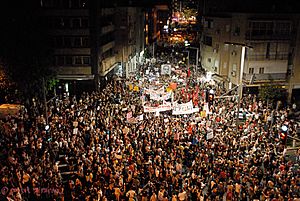
On July 14, 2011, the largest social protest in Israel's history began. Hundreds of thousands protested the rising cost of living, especially housing, and the decline of public services.
In October 2011, a deal was reached between Israel and Hamas: kidnapped Israeli soldier Gilad Shalit was released in exchange for 1,027 Palestinian prisoners. In November 2012, Israel began Operation Pillar of Defense in Gaza in response to rocket attacks, targeting Hamas military leaders and missile sites. In January 2013, the barrier on the Israeli-Egyptian border was completed.
Benjamin Netanyahu was elected Prime Minister again in the 2013 election. In July 2013, Israel released 104 Palestinian prisoners as a gesture to restart peace talks. In April 2014, Israel suspended peace talks after Hamas and Fatah agreed to form a unity government.
Following an increase in rocket attacks by Hamas, Israel started Operation Protective Edge in Gaza on July 8, 2014. This included a ground invasion to destroy cross-border tunnels.
After the 2015 elections, Netanyahu renewed his term as Prime Minister. A wave of lone-wolf attacks by Palestinians occurred in 2015 and 2016.
On December 6, 2017, President Donald Trump formally announced United States recognition of Jerusalem as the capital of Israel. In March 2018, Palestinians in Gaza began "the Great March of Return," weekly protests along the Gaza–Israel border.
The COVID-19 pandemic began in Israel in February 2020. The government implemented lockdowns and mask mandates. A vaccination campaign began in December 2020.
In late 2020, Israel normalized relations with four Arab League countries: the United Arab Emirates, Bahrain, Sudan, and Morocco, in what became known as the Abraham Accords. In May 2021, tensions in Jerusalem escalated, leading to eleven days of fighting between Israel and Hamas in Gaza.
Israel experienced a period of political instability from 2019 to 2022, with five elections. In March 2020, Netanyahu and Benny Gantz formed a unity government due to the COVID-19 pandemic, but it collapsed in December.
Recent Years: Bennett, Lapid, and Netanyahu III (2021–present)
Following the March 2021 election, Naftali Bennett formed a coalition government with Yair Lapid and other parties. Bennett served as Prime Minister, with Lapid set to take over later. For the first time in decades, an Israeli Arab party, Ra'am, was part of the government coalition.
In June 2022, the government coalition faced legislative defeats, and Bennett announced new elections for November. Yair Lapid became the interim Prime Minister. After the 2022 elections, Netanyahu returned as Prime Minister, forming what was described as the most right-wing government in Israel's history.
Population Changes Over Time
| 65 CE | 100 CE | 150 CE | 300 CE | 550 CE | 650 CE | |
|---|---|---|---|---|---|---|
| Estimated Jewish Population (thousands) | 2,500 | 1,800 | 1,200 | 500 | 200 | 100 |
| Estimated Total Population | 3,000 | 2,300 | 1,800 | 1,100 | 1,500 | 1,500 |
| 1950 | 1960 | 1970 | 1980 | 1990 | 2000 | 2010 | 2020 | |
|---|---|---|---|---|---|---|---|---|
| Population (thousands) | 1,370.1 | 2,150.4 | 3,022.1 | 3,921.7 | 4,821.7 | 6,369.3 | 7,695.1 | 9,097.0 |
| World Jewry percentage | 6% | 15% | 20% | 25% | 30% | 38% | 42% | 44% |
| GDP per capita (current US$) | 1,366 | 1,806 | 5,617 | 11,264 | 19,859 | 28,522 | 34,788 |
Images for kids
-
"Hezekiah ... king of Judah" - Royal seal written in the Paleo-Hebrew alphabet, unearthed in Jerusalem.
See also
 In Spanish: Historia del Estado de Israel para niños
In Spanish: Historia del Estado de Israel para niños
- Archaeology of Israel
- Hebrew calendar
- History of the Arab–Israeli conflict
- History of the Israel Defense Forces
- History of Jerusalem
- History of the Jews and Judaism in the Land of Israel
- History of the Middle East
- History of Palestine
- History of Zionism
- Jewish history
- Jewish military history
- Levantine archaeology
- LGBT history in Israel
- List of Israeli museums
- List of Jewish leaders in the Land of Israel
- List of years in Israel
- Politics of Israel
- Postage stamps and postal history of Israel
- Time periods in the Palestine region
- Timeline of Israeli history
- Timeline of the history of the region of Palestine


